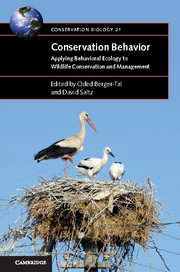Book contents
- Frontmatter
- Dedication
- Contents
- List of contributors
- Prologue
- Preface
- Acknowledgments
- Part I The integration of two disciplines: conservation and behavioral ecology
- 1 Introduction: the whys and the hows of conservation behavior
- 2 Evolution and conservation behavior
- 3 Learning and conservation behavior: an introduction and overview
- Part II Anthropogenic impacts on animal behavior and their implications for conservation and management
- Part III Behavior-based management: using behavioral knowledge to improve conservation and management efforts
- Part IV Behavioral indicators
- Index
- References
2 - Evolution and conservation behavior
from Part I - The integration of two disciplines: conservation and behavioral ecology
Published online by Cambridge University Press: 05 April 2016
- Frontmatter
- Dedication
- Contents
- List of contributors
- Prologue
- Preface
- Acknowledgments
- Part I The integration of two disciplines: conservation and behavioral ecology
- 1 Introduction: the whys and the hows of conservation behavior
- 2 Evolution and conservation behavior
- 3 Learning and conservation behavior: an introduction and overview
- Part II Anthropogenic impacts on animal behavior and their implications for conservation and management
- Part III Behavior-based management: using behavioral knowledge to improve conservation and management efforts
- Part IV Behavioral indicators
- Index
- References
Summary
All behavior occurs within the theater of evolution and hence it would be remiss to ignore evolutionary forces and outcomes when considering how behavior and conservation interact with each other. This is particularly pertinent as conservation outcomes can play out over a long time period, increasing the probability that conservation of biota will be affected by evolutionary forces and the evolutionary responses of organisms and communities to such forces.
To interweave evolutionary thinking into an approach to conservation behavior I will first, briefly, review how evolution works and offer a primer on micro-evolutionary forces. From there I will build evidence for how human alteration of the environment influences evolutionary forces and biological outcomes. Importantly, I will also layer-on a view of how macro-evolutionary patterns relate to conservation outcomes over long time periods, framed in the context of modern threats to biodiversity.
This evolutionary foundation lets me argue that behavior can lead evolution and not just be the outcome of evolutionary forces. Hence, behavioral mechanisms can alter evolutionary trajectories over a surprisingly short time period and affect conservation outcomes; a view not commonly held even among evolutionary biologists. This view will be integrated back to this book's initial framework of how behavior and conservation intersect with each other, revising the Berger-Tal et al. (2011) model to explicitly include micro- and macro-evolutionary forces, patterns and outcomes.
A BRIEF PRIMER ON MICRO-EVOLUTIONARY FORCES
Evolution is classically defined as the change in allele frequencies in a population over time (Maynard Smith & Szathmáry 1995, Stearns & Hoekstra 2005, Swaddle 2010). What this definition does not readily admit to is that this is perhaps an overly gene-centric definition of micro-evolution, yet our concept of evolution is much larger than tracking gene variants over time. Evolution is really the change in heritable variation in populations (defined broadly, as I will explain later when tackling macro-evolutionary topics) over time. By heritable variation I mean differences in a population that can be passed on from one generation to another, which can occur by many mechanisms including traditional genetic inheritance, epigenetic processes, parental effects, and some would argue by cultural inheritance also.
- Type
- Chapter
- Information
- Conservation BehaviorApplying Behavioral Ecology to Wildlife Conservation and Management, pp. 36 - 65Publisher: Cambridge University PressPrint publication year: 2016
References
- 1
- Cited by

